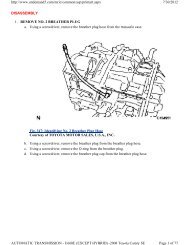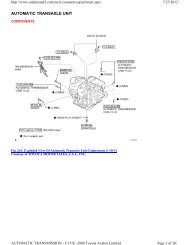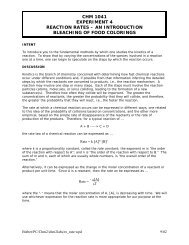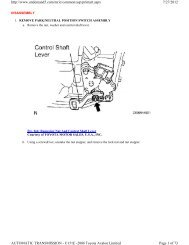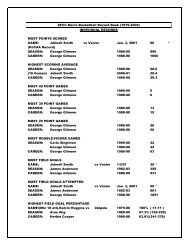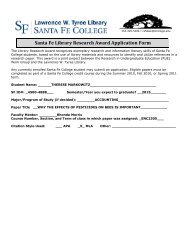1 MAC1105, College Algebra Study Questions for Common Final ...
1 MAC1105, College Algebra Study Questions for Common Final ...
1 MAC1105, College Algebra Study Questions for Common Final ...
You also want an ePaper? Increase the reach of your titles
YUMPU automatically turns print PDFs into web optimized ePapers that Google loves.
Solutions to <strong>Study</strong> <strong>Questions</strong> MAC 1105, <strong>College</strong> <strong>Algebra</strong> <strong>Final</strong> Exam<br />
1. a. Function (all input values are different and thus each input has one and only one output)<br />
b. Function (all input values are different and thus each input has one and only one output)<br />
c. Not a function [same input values have different output values]<br />
d. Not a function [same input values have different output values]<br />
2. a. Not a function: fails the vertical line test, e.g., look at the y-axis.<br />
b. Function: passes the vertical line test.<br />
c. Function; passes the vertical line test.<br />
3. The equation is C = 2.00 + 0.32M. It represents a function. The independent value is M<br />
measured in miles. The dependant variable is C measured in dollars. Here is a table of values:<br />
Miles Cost ($) Miles Cost ($)<br />
0 2.00 30 11.60<br />
10 5.20 40 14.80<br />
20 8.40 50 18.00<br />
4. a. p(-4) = 0.063, p(5) = 32 and p(1) = 2 ; b. n = 1 only<br />
5. a. f(-2) = 5, f(-1) = 0, f(0) = -3, and f(1) = -4<br />
b. f(x) = -3 if and only if x = 0 or 2.<br />
c. [-4, ∞), The range of f is from -4 to + ∞ including -4, since we may assume that its arms are<br />
extended out indefinitely.<br />
6. a. [-6, -3) and (5, 11)<br />
b. (-3, 5) and (11,12]<br />
c. (-6, 2) and (8, 12)<br />
d. (2,8)<br />
e. concave down over (0,5) and concave up over (5,8)<br />
f. x =1 or x = 3.5<br />
g. f(-8) is undefined<br />
7. a. Johnsonville’s population goes from 2.4 ∙ 100,000 = 240,000 to 5.8 ∙ 100,000 = 580,000.<br />
Range <strong>for</strong> Johnsonville: [240,000, 580,000]; Palm City’s population ranges from 1.8 ∙ 100,000<br />
= 180,000 to a high of 3.8 ∙ 100,000 = 380,000. Range <strong>for</strong> Palm City: [180,000, 380,000] (This<br />
notation adheres to what is found in the graph.)<br />
b. The population of Palm City increased from 1900 to 1930.<br />
c. The population of Palm City decreased from 1930 to 1990.<br />
d. The two populations were equal sometime around 1940.<br />
23





